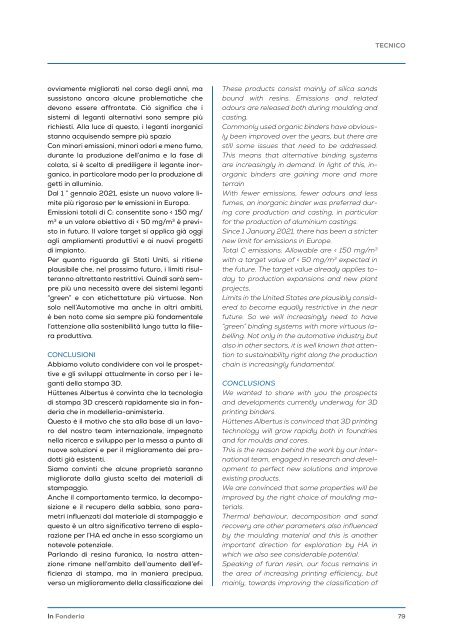In Fonderia 1 2024
Primo numero del 2024 di In Fonderia
Primo numero del 2024 di In Fonderia
Create successful ePaper yourself
Turn your PDF publications into a flip-book with our unique Google optimized e-Paper software.
TECNICO<br />
ovviamente migliorati nel corso degli anni, ma<br />
sussistono ancora alcune problematiche che<br />
devono essere affrontate. Ciò significa che i<br />
sistemi di leganti alternativi sono sempre più<br />
richiesti. Alla luce di questo, i leganti inorganici<br />
stanno acquisendo sempre più spazio<br />
Con minori emissioni, minori odori e meno fumo,<br />
durante la produzione dell’anima e la fase di<br />
colata, si è scelto di prediligere il legante inorganico,<br />
in particolare modo per la produzione di<br />
getti in alluminio.<br />
Dal 1 ° gennaio 2021, esiste un nuovo valore limite<br />
più rigoroso per le emissioni in Europa.<br />
Emissioni totali di C: consentite sono < 150 mg/<br />
m 3 e un valore obiettivo di < 50 mg/m 3 è previsto<br />
in futuro. Il valore target si applica già oggi<br />
agli ampliamenti produttivi e ai nuovi progetti<br />
di impianto.<br />
Per quanto riguarda gli Stati Uniti, si ritiene<br />
plausibile che, nel prossimo futuro, i limiti risulteranno<br />
altrettanto restrittivi. Quindi sarà sempre<br />
più una necessità avere dei sistemi leganti<br />
“green” e con etichettature più virtuose. Non<br />
solo nell’Automotive ma anche in altri ambiti,<br />
è ben noto come sia sempre più fondamentale<br />
l’attenzione alla sostenibilità lungo tutta la filiera<br />
produttiva.<br />
CONCLUSIONI<br />
Abbiamo voluto condividere con voi le prospettive<br />
e gli sviluppi attualmente in corso per i leganti<br />
della stampa 3D.<br />
Hüttenes Albertus è convinta che la tecnologia<br />
di stampa 3D crescerà rapidamente sia in fonderia<br />
che in modelleria-animisteria.<br />
Questo è il motivo che sta alla base di un lavoro<br />
del nostro team internazionale, impegnato<br />
nella ricerca e sviluppo per la messa a punto di<br />
nuove soluzioni e per il miglioramento dei prodotti<br />
già esistenti.<br />
Siamo convinti che alcune proprietà saranno<br />
migliorate dalla giusta scelta dei materiali di<br />
stampaggio.<br />
Anche il comportamento termico, la decomposizione<br />
e il recupero della sabbia, sono parametri<br />
influenzati dal materiale di stampaggio e<br />
questo è un altro significativo terreno di esplorazione<br />
per l’HA ed anche in esso scorgiamo un<br />
notevole potenziale.<br />
Parlando di resina furanica, la nostra attenzione<br />
rimane nell’ambito dell’aumento dell’efficienza<br />
di stampa, ma in maniera precipua,<br />
verso un miglioramento della classificazione dei<br />
These products consist mainly of silica sands<br />
bound with resins. Emissions and related<br />
odours are released both during moulding and<br />
casting.<br />
Commonly used organic binders have obviously<br />
been improved over the years, but there are<br />
still some issues that need to be addressed.<br />
This means that alternative binding systems<br />
are increasingly in demand. <strong>In</strong> light of this, inorganic<br />
binders are gaining more and more<br />
terrain<br />
With fewer emissions, fewer odours and less<br />
fumes, an inorganic binder was preferred during<br />
core production and casting, in particular<br />
for the production of aluminium castings.<br />
Since 1 January 2021, there has been a stricter<br />
new limit for emissions in Europe.<br />
Total C emissions: Allowable are < 150 mg/m 3<br />
with a target value of < 50 mg/m 3 expected in<br />
the future. The target value already applies today<br />
to production expansions and new plant<br />
projects.<br />
Limits in the United States are plausibly considered<br />
to become equally restrictive in the near<br />
future. So we will increasingly need to have<br />
“green” binding systems with more virtuous labelling.<br />
Not only in the automotive industry but<br />
also in other sectors, it is well known that attention<br />
to sustainability right along the production<br />
chain is increasingly fundamental.<br />
CONCLUSIONS<br />
We wanted to share with you the prospects<br />
and developments currently underway for 3D<br />
printing binders.<br />
Hüttenes Albertus is convinced that 3D printing<br />
technology will grow rapidly both in foundries<br />
and for moulds and cores.<br />
This is the reason behind the work by our international<br />
team, engaged in research and development<br />
to perfect new solutions and improve<br />
existing products.<br />
We are convinced that some properties will be<br />
improved by the right choice of moulding materials.<br />
Thermal behaviour, decomposition and sand<br />
recovery are other parameters also influenced<br />
by the moulding material and this is another<br />
important direction for exploration by HA in<br />
which we also see considerable potential.<br />
Speaking of furan resin, our focus remains in<br />
the area of increasing printing efficiency, but<br />
mainly, towards improving the classification of<br />
<strong>In</strong> <strong>Fonderia</strong><br />
79














